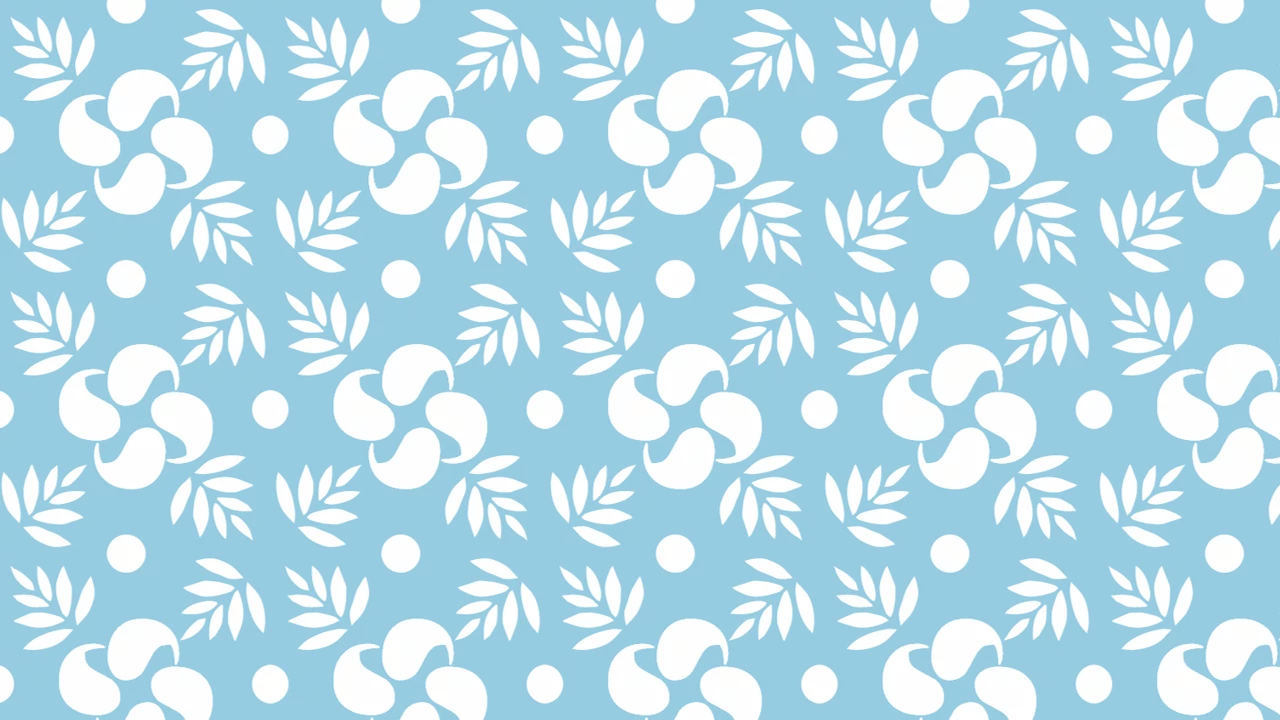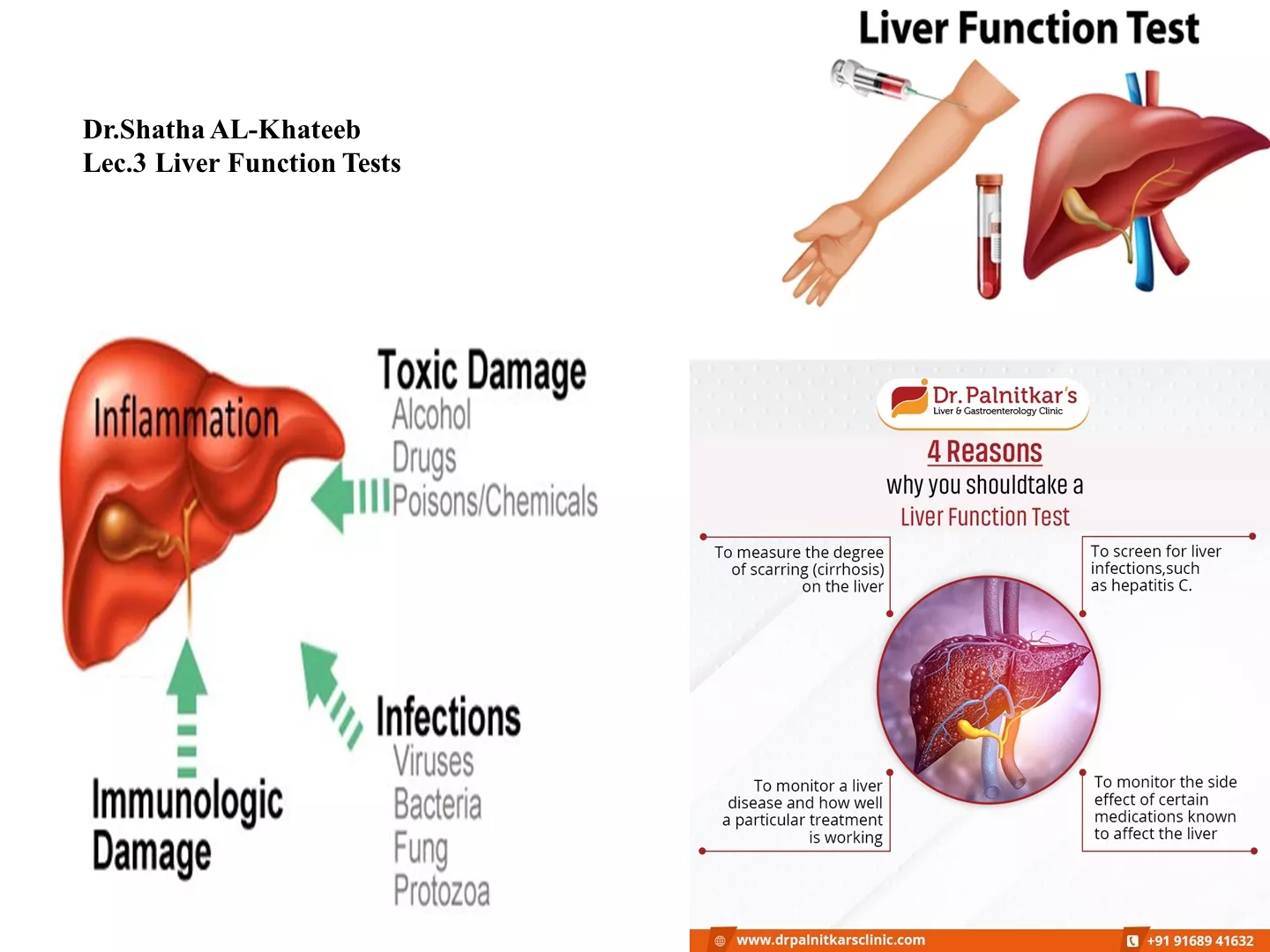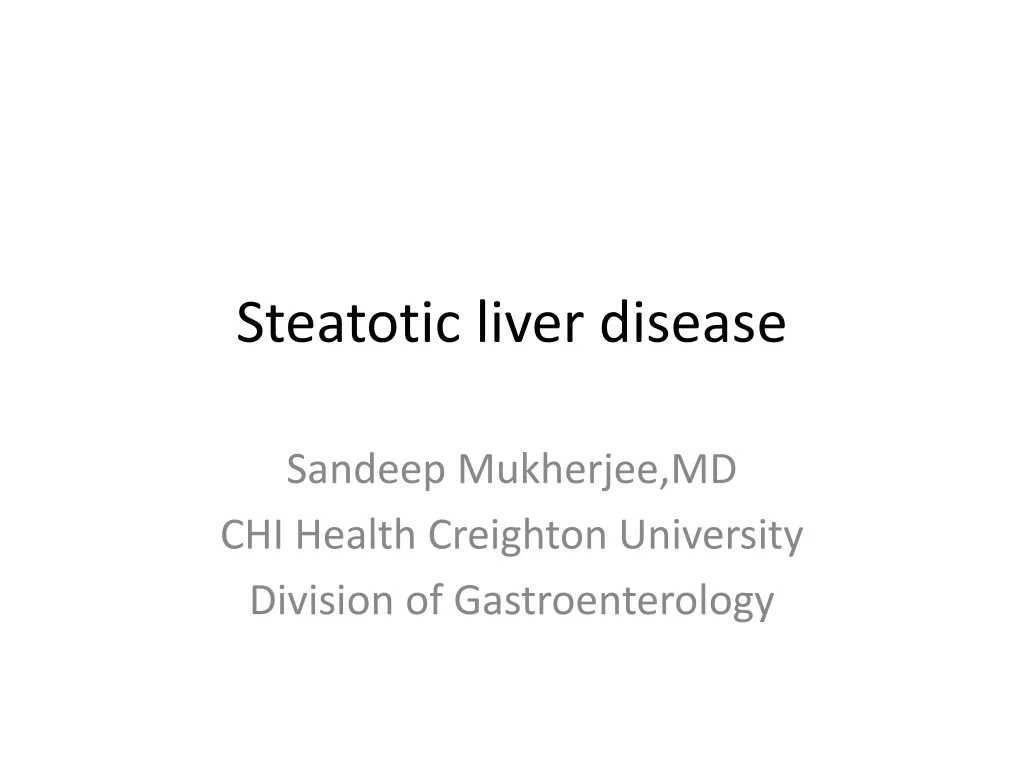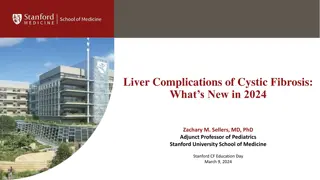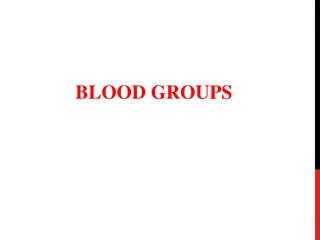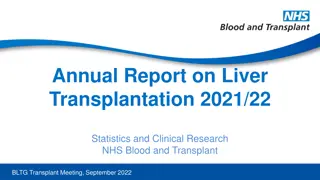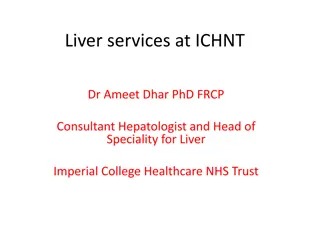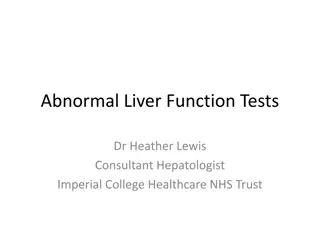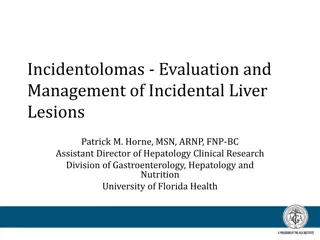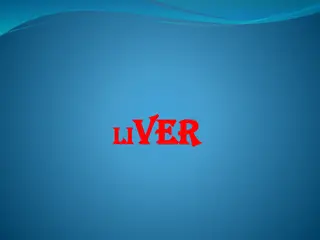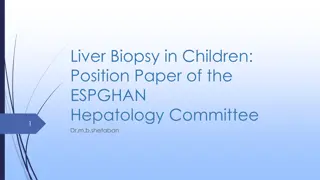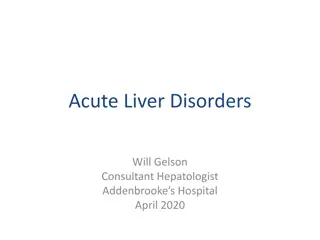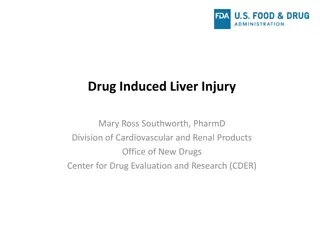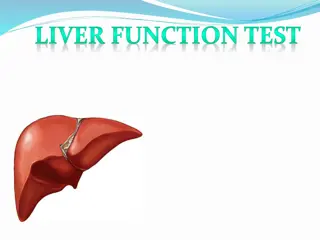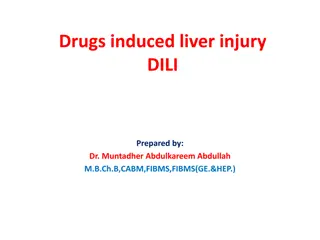Functional Anatomy and Blood Supply of the Liver
The liver is a crucial organ with dual functions and a complex anatomical structure. It consists of hepatic lobes and lobules, where hepatocytes play a vital role in various functions. The liver receives blood supply from both the hepatic artery and portal vein, allowing for essential processes such as bile secretion and detoxification to take place effectively.
Download Presentation

Please find below an Image/Link to download the presentation.
The content on the website is provided AS IS for your information and personal use only. It may not be sold, licensed, or shared on other websites without obtaining consent from the author.If you encounter any issues during the download, it is possible that the publisher has removed the file from their server.
You are allowed to download the files provided on this website for personal or commercial use, subject to the condition that they are used lawfully. All files are the property of their respective owners.
The content on the website is provided AS IS for your information and personal use only. It may not be sold, licensed, or shared on other websites without obtaining consent from the author.
E N D
Presentation Transcript
THE LIVER AND BILARY APPARATUS BY NWUME BRENDA EBELECHUKWU- 17/MHS01/214 NZERIBE CHIZITERE ADAEZE- 17/MHS01/217
CONTENTS INTRODUCTION TO THE LIVER. FUNCTIONAL ANATOMY OF THE LIVER. BLOOD SUPPLY TO THE LIVER. FUNCTIONS OF THE LIVER BILIARY SYSTEM. PROPERTIES AND COMPOSITIONOF BILE. STORAGE OF BILE. FUNCTIONS OF BILE. GALLBLADDER. FUNCTIONS OF GALLBLADDER. APPLIED PHYSIOLOGY.
INTRODUCTION TO THE LIVER. Liver is a dual organ having both secretory and excretory functions. It is the largest gland in the body, weighing about 1.5 kg in man. It is located in the upper and right side of the abdominal cavity, immediately beneath diaphragm.
FUNCTIONAL ANATOMY OF THE LIVER. Hepatic Lobes Liver is made up of many lobes called hepatic lobes. Each lobe consists of many lobules called hepatic lobules. Hepatic Lobules Hepatic lobule is the structural and functional unit of liver. There are about 50,000 to 100,000 lobules in the liver. The lobule is a honeycomb-like structure and it is made up of liver cells called hepatocytes. Hepatocytes and Hepatic Plates Hepatocytes are arranged in columns, which form the hepatic plates. Each plate is made up of two columns of cells. In between the two columns of each plate lies a bile canaliculus. In between the neighboring plates, a blood space called sinusoid is present. Sinusoid is lined by the endothelial cells. In between the endothelial cells some special macrophages called Kupffer cells are present.
FUNCTIONAL ANATOMY OF THE LIVER CONT D. Portal Triads Each lobule is surrounded by many portal triads. Each portal triad consists of three vessels: 1. A branch of hepatic artery 2. A branch of portal vein 3. A tributary of bile duct. Branches of hepatic artery and portal vein open into the sinusoid. Sinusoid opens into the central vein. Central vein empties into hepatic vein. Bile is secreted by hepatic cells and emptied into bile canaliculus. From canaliculus, the bile enters the tributary of bile duct. Tributaries of bile duct from canaliculi of neighboring lobules unite to form small bile ducts. These small bile ducts join together and finally form left and right hepatic ducts, which emerge out of liver.
BLOOD SUPPLY TO THE LIVER. Liver receives maximum blood supply of about 1,500 mL/minute. It receives blood from two sources, namely the hepatic artery and portal vein. HEPATIC ARTERY. Hepatic artery arises directly from aorta and supplies oxygenated blood to liver. After entering the liver, the hepatic artery divides into many branches. Each branch enters a portal triad. PORTAL VEIN. Portal vein is formed by superior mesenteric vein and splenic vein. It brings deoxygenated blood from stomach, intestine, spleen and pancreas. Portal blood is rich in monosaccharides and amino acids. It also contains bile salts, bilirubin, urobilinogen and GI hormones. However, the oxygen content is less in portal blood. Flow of blood from intestine to liver through portal vein is known as enterohepatic circulation. The blood from hepatic artery mixes with blood from portal vein in hepatic sinusoids. Hepatic cells obtain oxygen and nutrients from the sinusoid.
FUNCTIONS OF THE LIVER. Liver is the largest gland and one of the vital organs of the body. It performs many vital metabolic and homeostatic functions, which are summarized below. .1. METABOLIC FUNCTION: Liver is the organ where maximum metabolic reactions such as metabolism of carbohydrates, proteins, fats, vitamins and many hormones are carried out. .2. STORAGE FUNCTION: Many substances like glycogen, amino acids, iron, folic acid and vitamins A, B12 and D are stored in liver. .3. SYNTHETIC FUNCTION: Liver produces glucose by gluconeogenesis. It synthesizes all the plasma proteins and other proteins (except immunoglobulins) such as clotting factors, complement factors and hormonebinding proteins. It also synthesizes steroids, somatomedin and heparin. .4. SECRETION OF BILE: Liver secretes bile which contains bile salts, bile pigments, cholesterol, fatty acids and lecithin. The functions of bile are mainly due to bile salts. Bile salts are required for digestion and absorption of fats in the intestine. Bile helps to carry away waste products and breakdown fats, which are excreted through feces or urine.
FUNCTIONS OF THE LIVER CONTD. .5. EXCRETORY FUNCTION: Liver excretes cholesterol, bile pigments, heavy metals (like lead, arsenic and bismuth), toxins, bacteria and virus (like that of yellow fever) through bile. .6. HEAT PRODUCTION: Enormous amount of heat is produced in the liver because of metabolic reactions. Liver is the organ where maximum heat is produced. .7. HEMOPOIETIC FUNCTION: In fetus (hepatic stage), liver produces the blood cells. It stores vitamin B12 necessary for erythropoiesis and iron necessary for synthesis of hemoglobin. Liver produces thrombopoietin that promotes production of thrombocytes. .8. HEMOLYTIC FUNCTION: The senile RBCs after a lifespan of 120 days are destroyed by reticuloendothelial cells (Kupffer cells) of liver. .9. INACTIVATION OF HORMONES AND DRUGS: Liver catabolizes the hormones such as growth hormone, parathormone, cortisol, insulin, glucagon and estrogen. It also inactivates the drugs, particularly the fatsoluble drugs. The fatsoluble drugs are converted into wate rsoluble substances, which are excreted through bile or urine.
FUNCTIONS OF LIVER CONTD. .10. DEFENSIVE AND DETOXIFICATION FUNCTIONS: Reticuloendothelial cells (Kupffer cells) of the liver play an important role in the defense of the body. Liver is also involved in the detoxification of the foreign bodies. i. Foreign bodies such as bacteria or antigens are swallowed and digested by reticuloendothelial cells of liver by means of phagocytosis. ii. Reticuloendothelial cells of liver also produce substances like interleukins and tumor necrosis factors, which activate the immune system of the body. iii. Liver cells are involved in the removal of toxic property of various harmful substances. Removal of toxic property of the harmful agent is known as detoxification. Detoxification in liver occurs in two ways: a. Total destruction of the substances by means of metabolic degradation. b. Conversion of toxic substances into nontoxic materials by means of conjugation with glucuronic acid or sulfates.
THE BILIARY SYSTEM. Biliary system or extrahepatic biliary apparatus is formed by gallbladder and extrahepatic bile ducts (bile ducts outside the liver). Right and left hepatic bile ducts which come out of liver join to form common hepatic duct. It unites with the cystic duct from gallbladder to form common bile duct. All these ducts have similar structures. Common bile duct unites with pancreatic duct to form the common hepatopancreatic duct or ampulla of Vater, which opens into the duodenum. There is a sphincter called sphincter of Oddi at the lower part of common bile duct, before it joins the pancreatic duct. It is formed by smooth muscle fibers of common bile duct. It is normally kept closed; so the bile secreted from liver enters gallbladder where it is stored. Upon appropriate stimulation, the sphincter opens and allows flow of bile from gallbladder into the intestine.
PROPERTIES AND COMPOSITION OF BILE. PROPERTIES OF BILE Volume : 800 to 1,200 mL/day Reaction : Alkaline pH : 8 to 8.6 Specific gravity : 1.010 to 1.011 Color : Golden yellow or green COMPOSITION OF BILE Bile contains 97.6% of water and 2.4% of solids. Solids include organic and inorganic substances.
FUNCTIONS OF BILE. 1. DIGESTIVE FUNCTION: Emulsification is the process by which the fat globules are broken down into minute droplets and made in the form of a milky fluid called emulsion in small intestine, by the action of bile salts. Lipolytic enzymes of GI tract cannot digest the fats directly because the fats are insoluble in water due to the surface tension. Bile salts emulsify the fats by reducing the surface tension due to their detergent action. Now the fats can be easily digested by lipolytic enzymes. Unemulsified fat usually passes through the intestine and then it is eliminated in feces. Emulsification of fats by bile salts needs the presence of lecithin from bile. 2. ABSORPTIVE FUNCTION: Bile salts help in the absorption of digested fats from intestine into blood. Bile salts combine with fats and make complexes of fats called micelles. The fats in the form of micelles can be absorbed easily. 3. EXCRETORY FUNCTIONS: Bile pigments are the major excretory products of the bile. Other substances excreted in bile are: i. Heavy metals like copper and iron ii. Some bacteria like typhoid bacteria iii. Some toxins iv. Cholesterol v. Lecithin vi. Alkaline phosphatase
FUNCTIONS OF BILE CONTD. 4. LAXATIVE ACTION: Bile salts act as laxatives. 5. ANTISEPTIC ACTION: Bile inhibits the growth of certain bacteria in the lumen of intestine by its natural detergent action. 6. CHOLERETIC ACTION: Bile salts have the choleretic action. 7. MAINTENANCE OF pH IN GASTROINTESTINAL TRACT: As bile is highly alkaline, it neutralizes the acid chyme which enters the intestine from stomach. Thus, an optimum pH is maintained for the action of digestive enzymes. 8. PREVENTION OF GALLSTONE FORMATION: Bile salts prevent the formation of gallstone by keeping the cholesterol and lecithin in solution. In the absence of bile salts, cholesterol precipitates along with lecithin and forms gallstone. 9. LUBRICATION FUNCTION: The mucin in bile acts as a lubricant for the chyme in intestine. 10. CHOLAGOGUE ACTION: Bile salts act as cholagogues.
THE GALLBLADDER. Bile secreted from liver is stored in gallbladder. The capacity of gallbladder is approximately 50 mL. Gallbladder is not essential for life and it is removed (cholecystectomy) in patients suffering from gallbladder dysfunction. After cholecystectomy, patients do not suffer from any major disadvantage. In some species, gallbladder is absent.
FUNCTIONS OF GALLBLADDER. 1. Storage of Bile: Bile is continuously secreted from liver. But it is released into intestine only intermittently and most of the bile is stored in gallbladder till it is required. 2. Concentration of Bile: Bile is concentrated while it is stored in gallbladder. The mucosa of gallbladder rapidly reabsorbs water and electrolytes, except calcium and potassium. But the bile salts, bile pigments, cholesterol and lecithin are not reabsorbed. So, the concentration of these substances in bile increases 5 to 10 times. 3. Alteration of Ph of Bile: The pH of bile decreases from 8 8.6 to 7 7.6 and it becomes less alkaline when it is stored in gallbladder. 4. Secretion of Mucin: Gallbladder secretes mucin and adds it to bile. When bile is released into the intestine, mucin acts as a lubricant for movement of chyme in the intestine. 5. Maintenance of Pressure in Biliary System: Due to the concentrating capacity, gallbladder maintains a pressure of about 7 cm H2O in biliary system. This pressure in the biliary system is essential for the release of bile into the intestine.
APPLIED PHYSIOLOGY. JAUNDICE OR ICTERUS: Jaundice or icterus is the condition characterized by yellow coloration of the skin, mucous membrane and deeper tissues due to increased bilirubin level in blood. The word jaundice is derived from the French word jaune meaning yellow. The normal serum bilirubin level is 0.5 to 1.5 mg/dL. Jaundice occurs when bilirubin level exceeds 2 mg/dl. HEPATITIS: Hepatitis is the liver damage caused by many agents. It is characterized by swelling and inadequate functioning of liver. Hepatitis may be acute or chronic. In severe conditions, it may lead to liver failure and death. CIRRHOSIS OF LIVER: Cirrhosis of liver refers to inflammation and damage of parenchyma of liver. It results in degeneration of hepatic cells and dysfunction of liver. GALLSTONES:Gallstone is a solid crystal deposit that is formed by cholesterol, calcium ions and bile pigments in the gallbladder or bile duct. Cholelithiasis is the presence of gallstones in gallbladder. Choledocholithiasis is the presence of gallstones in the bile ducts.
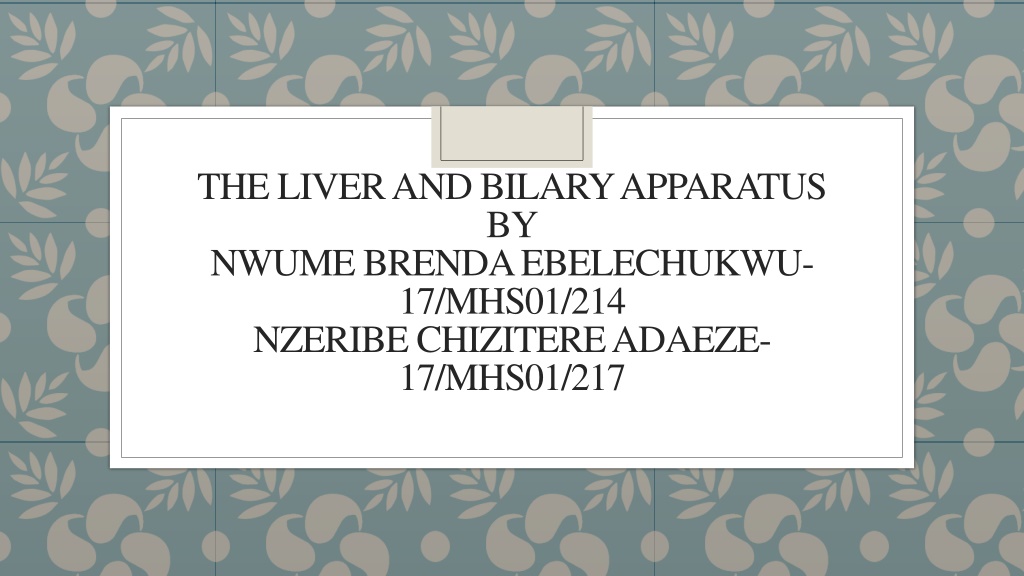
 undefined
undefined